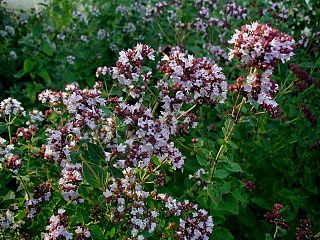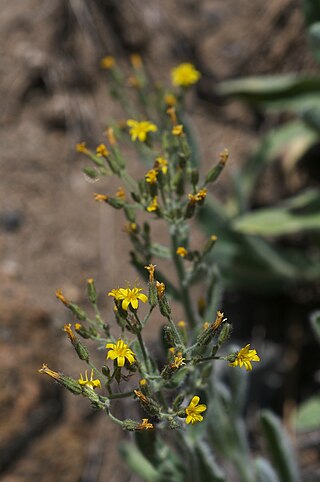
Origanum is a genus of herbaceous perennials and subshrubs in the family Lamiaceae, native to Europe, North Africa, and much of temperate Asia, where they are found in open or mountainous habitats. A few species also naturalized in scattered locations in North America and other regions.

Hieracium horridum, known as the prickly hawkweed or shaggy hawkweed, is a species of plant in the family Asteraceae. It gets its name from the long, dense, shaggy white to brown hairs (trichomes) which cover all of the plant parts of this plant species. The species is native to Oregon, California, and Nevada in the western United States.
Lactuca orientalis is a Eurasian species of plant in the tribe Cichorieae within the family Asteraceae. It is widespread across the Middle East and southern Asia as far east as Tibet.
Rhizocephalus is a genus of plants in the grass family, Poaceae. The only known species is Rhizocephalus orientalis, native to Afghanistan, Armenia, Georgia, Iran, Iraq, Israel, Jordan, Lebanon, Palestine, Syria, AsiaticTurkey, and Uzbekistan.

Viola libanotica is a species of flowering plant in the Violaceae family. It is referred to by the common name Lebanon violet and is an evergreen running herb. It is endemic to the cold heights of Lebanon. The plant has dark green leaves. The flowers are purple.

Origanum libanoticum is a species of herbaceous flowering plant in the family Lamiaceae, native to the mountains of Lebanon and Syria.

Rhamnus libanotica is a species of flowering plant in the Rhamnaceae family. It is referred to by the common name Lebanese buckthorn, and is native to Western Asia from Lebanon and Syria to Turkey.
Tulipa aleppensis is a wild tulip in the family Liliaceae. It is native to Southeastern Turkey, Syria, near Beirut in Lebanon.

Iris bismarckiana, the Nazareth iris, is a species in the genus Iris, it is also in the subgenus Iris and in the section Oncocyclus. It is a rhizomatous perennial, from the mountainsides of Israel, Lebanon, Jordan and Syria. It has stoloniferous, spreading rhizomes, long, sword shaped, bright green leaves, long slender stem and 1 flower in Spring. The large flower is pale yellow, creamy-white, or white background. Which is covered with reddish-brown, maroon brown, purple-brown, purple, blue-purple, or blue veins, markings or spots. It has a dark signal patch and dark purple to black beard. It is rarely cultivated as an ornamental plant in temperate regions, as it needs very dry conditions during the summer.
Iris cedreti is a species of flowering plant in the genus Iris; it is also in the subgenus of Iris. It is a rhizomatous perennial endemic to Lebanon. It has long narrow leaves, short stem, and flowers with a white background which is covered with very small dots or veins of dark maroon, purple, purplish-maroon, or almost black. It has a dark maroon signal patch with a brownish or purplish beard. It is rarely cultivated as an ornamental plant in temperate regions, as it needs very dry conditions during the summer. It is listed as critically endangered by the IUCN.
Iris heylandiana is a species in the genus Iris, it is also in the subgenus Iris, and in the section Oncocyclus. It is a rhizomatous perennial, from the marshlands or fields of Iraq. It has short, linear or sickle shaped grey-green leaves, slender stem, a single flower in spring, which has a dingy-white, whitish, or pale background, which is covered in many spots or dark veining, in black-purple, brown-purple, or brown violet, or brown shades. It has a dark brown or burgundy brown signal patch and white tinged with yellow or orange white sparse beard. It is rarely cultivated as an ornamental plant in temperate regions, as it needs very dry conditions during the summer.

Hymenonema laconicum is a species of herbaceous perennial plant in the Asteraceae family. It is small to average height, with a rosette of greyish pinnately segmented leaves, and little branching solid stems carrying one to three heads of orange or yolk yellow ray-flowers, with a purple anther tube, and scaly pappus. The species is an endemic of the central and south-eastern Peloponnesos, and flowers in May and June.

Aria graeca, also known as the Greek whitebeam and fan-leaved service-tree, is a species of whitebeam, in the rose family (Rosaceae).
Ornithogalum libanoticum, or Lebanon ornithogalum, is a species of Ornithogalum in the subfamily Scilloideae of family Asparagaceae.

Astragalus cedreti is a species of flowering plant in the legume family. It is a perennial plant with alternating, smooth pinnate leaves and red flowers. It blooms in June.

Hypericum przewalskii, commonly called Przewalski's St. John's wort, is a flowering plant in Hypericumsect. Roscyna that is native to China.
Vicia canescens is a species of legume in the vetch genus that is endemic to Lebanon.

Aubrieta libanotica, common name Lebanese rock cress, is a species of flowering plant in the mustard family Brassicaceae. The genus is named after Claude Aubriet, a French flower painter. A. Libanotica is native to the mountainous ranges of Lebanon and some parts of Syria.
Turgeniopsis is a monotypic genus of flowering plants belonging to the family Apiaceae. It contains only one known species, Turgeniopsis foeniculacea. The earlier synonym Glochidotheca is also used as the accepted genus name, but Plants of the World Online states that it was not validly published.
Parlatoria is a monotypic genus of flowering plants belonging to the family Brassicaceae. It just contains one species, Parlatoria cakiloideaBoiss.











